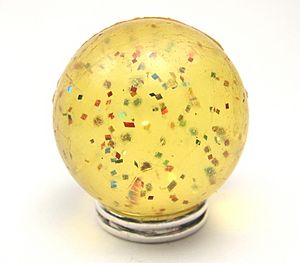Super Ball facts for kids
A Super Ball is a super bouncy toy ball. It was invented in 1964 by a chemist named Norman Stingley. This special ball is made from a type of synthetic rubber called Zectron. This material is very elastic, meaning it can stretch and return to its original shape. When you drop a Super Ball from your shoulder onto a hard floor, it bounces almost all the way back up! If an adult throws it down hard, it can even bounce higher than a three-story building.
Contents
The Story of the Super Ball
How the Super Ball Was Invented
Norman Stingley, the inventor, was looking for ways to use his new type of synthetic rubber. He first offered his idea to the company he worked for, but they weren't interested. They thought the material wasn't strong enough. So, Stingley took his invention to a toy company called Wham-O. Wham-O worked hard to make the ball more durable, and they still make Super Balls today!
Richard Knerr, who was the president of Wham-O in 1966, said it took them almost two years to perfect the Super Ball. He explained that the ball always had its amazing bounciness, but it used to break apart easily. They solved this problem by using a special high-pressure method to shape the balls. After that, they started selling millions of them!
The Super Ball Craze
When the Super Ball first came out, it became a huge fad. At its busiest, Wham-O made over 170,000 Super Balls every single day. By December 1965, more than six million balls had been sold! Even McGeorge Bundy, an adviser to the U.S. president, had five dozen Super Balls sent to the White House for the staff to enjoy.
Richard P. Knerr from Wham-O knew that fads don't last forever. He once joked that "Each Super Ball bounce is 92% as high as the last." He hoped their sales wouldn't drop any faster than that! At first, a full-sized Super Ball cost 98 cents. By the end of 1966, smaller, colorful versions were sold for as little as 10 cents in vending machines.
Giant Super Ball Stunt
In the late 1960s, Wham-O created a giant Super Ball for a special event. It was about the size of a bowling ball! This huge ball was dropped from the 23rd floor of a hotel in Australia. On its second bounce, it actually destroyed a car parked below!
Super Balls and Music
A composer named Alcides Lanza bought some Super Balls in 1965 for his son to play with. But he soon started experimenting with the sounds they made when rubbed along the strings of a piano. This led him to create a musical piece called Plectros III in 1971. In this piece, he instructs musicians to use two Super Balls on sticks to hit and rub the strings of a piano.
How the Super Bowl Got Its Name
Lamar Hunt was the founder of the American Football League (AFL) and owned the Kansas City Chiefs football team. He saw his children playing with a Super Ball and got an idea for a name. He wrote a letter to the National Football League (NFL) commissioner in July 1966. In the letter, he jokingly called the championship game the "Super Bowl."
Even though the league owners had decided to call it the AFL–NFL World Championship Game, the media quickly started using Hunt's "Super Bowl" name. It became the official name starting with the third annual game in 1969.
How Super Balls Work
Bouncing High
Super Balls are often used in high school physics classes to teach students about how things bounce. If you put a small ball bearing (a tiny metal ball) on top of a Super Ball and drop them together, the small ball can bounce much higher than you'd expect! This shows how energy can be transferred between objects during a bounce.
Spinning and Friction
When a Super Ball bounces, it often reverses its spin direction with each bounce. This happens because of how the ball's surface interacts with the ground. It's not just about how hard the ball is, but also how much it can "cling" to the surface for a moment before slipping. This makes the Super Ball's bounce behavior quite interesting and a bit complex!
More Information
- Stingley, Norman H. – "Highly Resilient Polybutadiene Ball"
See also
- The Absent-Minded Professor
- Happy Fun Ball



